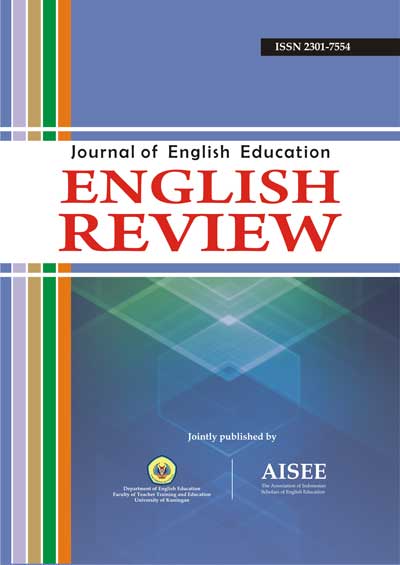ANALYSIS OF BARRIERS IN LISTENING COMPREHENSION AMONG JUNIOR HIGH SCHOOL STUDENTS
Abstract
Abstract: This research paper identifies barriers and difficulties in listening comprehension faced by junior high school students. The research questions were what barriers did students encounter and how did they used strategies to overcome those barriers. This study used a qualitative method and was a case study involving 40 students and one English teacher. The data were obtained by ways of conducting a test of listening taken from TOEIC test. The tests indicated that the results scores were not quite satisfactory. This is primarily caused by speech delivery of the native speaker which was too fast. This means that students faced listening barriers especially in processing information. The data also indicated that students were also nervous when doing the test as habitual barrier. Strategies used to overcome these barriers are by making students get used to listen and use English and making them familiar with certain contexts in real life.
Â
Keywords: listening barriers, listening comprehension, TOEIC test.
References
Brown, H.D. (2001). Teaching by principles: An interactive approach to language pedagogy. Second Ed.; Longman Press.
Chen, Y. (2005). Barriers to acquiring listening strategies for EFL learners and their pedagogical implications. TESL-EJ, Vol. 8 No. 4.
Depdiknas. (2003). Competence standard for english subject. Jakarta: Indonesia Ministry of Education.
________. (2006). Guidelines of curricullum in educational unit level (kurikulum tingkat satuan pendidikan). Jakarta: Indonesia Ministry of Education.
Gall, M. D., Gall, Joyce P., and Borg, Walter R. (2003). Educational research: An introduction, Seventh ed., Boston:Allyn Bacon.
Janusik, L. (2006). Listening facts. Rockhurst University, International Listening Association (ILA) journal.
Maxwell, J. (1996). Qualitative research design: An integrated approach. Thousand Oak, CA: Sage Publication.
OXFORD Practice Test for the TOEIC Test 2. (2000). Oxford: Oxford University Press.
Richards, J. C., and Rodgers, Theodore S. (1996). Approaches and Methods in Language Teaching. Forum Vol. XXV No. 4, Bandung: Tarsito
Rost, M. (1990). Listening in language learning, New York:Longman Inc.
______ .(2002). Teaching and researching listening. London: Edinburgh Gate, England, Pearson Education.
Sudjana, N. and Ibrahim. (2001). Penelitian dan penilaian pendidikan. Bandung: Sinar Baru Algesindo
Suryanti, Y. (2002). Exploring students’ difficulties in the listening class. Unpublisheb Thesis. Bandung: Indonesia University of Education.
Rixon, S. (1986). Developing listening skills. London: Mac Millan Publisher Limited
Underwood, M. (1989). Teaching listening, London: Longman.
Ur, Penny, 1984, Teaching listening comprehension. Cambridge: Cambridge University Press.
Wray, Alison, Trott, Kate and Bloomer, Allen, 1998, Projects in linguistics: A practical guide to researching language. London: Arnold
All articles published in English Review: Journal of English Education (ERJEE) are licensed under the Creative Commons Attribution 4.0 International License (CC BY 4.0).
Copyright Ownership
Authors retain the copyright of their articles and grant ERJEE the right of first publication. The journal is granted a non-exclusive license to publish, reproduce, and distribute the article in any format, medium, or platform, provided that proper credit is given to the original authors.
License Terms – CC BY 4.0
Under the Creative Commons Attribution 4.0 International License, others are free to:
- Share — copy and redistribute the material in any medium or format
- Adapt — remix, transform, and build upon the material for any purpose, even commercially
As long as they:
- Provide appropriate credit to the original author(s) and source
- Provide a link to the license (https://creativecommons.org/licenses/by/4.0/)
- Indicate if any changes were made
There are no restrictions on the reuse, reproduction, or adaptation of published articles as long as attribution is properly given.
Author Warranties
By submitting a manuscript to ERJEE, authors confirm that:
- The work is original and does not infringe any existing copyright.
- The manuscript has not been previously published and is not under consideration elsewhere.
- All sources and references are appropriately acknowledged.
- Necessary permissions have been obtained for any copyrighted materials used.










